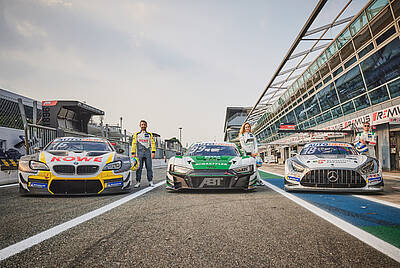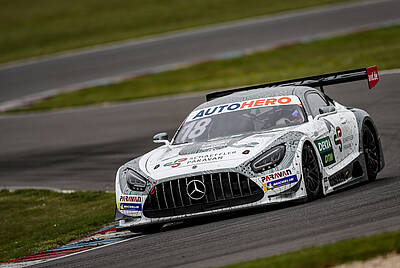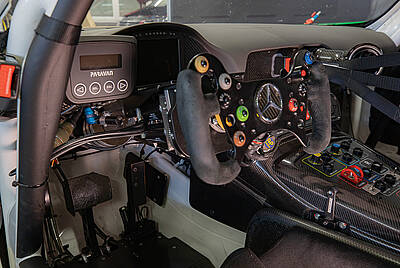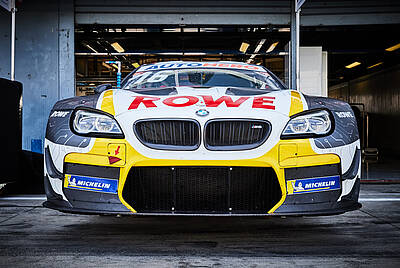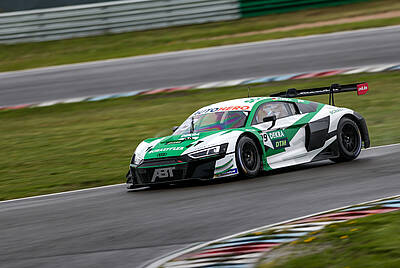- Audi, BMW, Mercedes-AMG: Steer-by-wire technology Space Drive is installed in three DTM cars
- Matthias Zink: "Use under extreme conditions demonstrates high degree of maturity of the technology and decisively advances development to series solution."
- Steering without mechanical connection: Space Drive is a key technology for new space concepts, simplified production and logistics as well as for autonomous driving
Next weekend, the DTM starts the 2021 season in Monza, Italy, and with it the next challenge for the Space Drive steer-by-wire technology from Schaeffler Paravan Technologie GmbH & Co. KG. Since this year, electronic steering, which does not require any mechanical connection between the steering unit and the steering gear, has been an integral part of the DTM regulations. For the 2021 season, therefore, the rule is: one system, three manufacturers, three drivers. On the grid:
- Mücke Motorsport's Mercedes-AMG GT3, driven by test driver and two-time DTM champion from 2005 and 2018 Gary Paffett (replaced by Maximilian Buhk in the first races at Monza and Lausitzring due to calendar corrections and Formula E commitments).
- The BMW M6 from ROWE Racing, driven by Formula 1 and DTM driver Timo Glock.
- And the Audi R8 LMS GT3 from ABT Sportsline, driven by Schaeffler brand ambassador Sophia Flörsch.
"As a series production partner of the DTM, Schaeffler is demonstrating its innovative strength and pioneering spirit," says Matthias Zink, Member of the Executive Board for Automotive Technologies at Schaeffler. "The use under extreme conditions proves the high degree of maturity of the technology and brings us decisively forward in the development towards a series solution. Space Drive is a highly proven key technology for autonomous driving with more than one billion kilometres driven on public roads." The automotive and industrial supplier Schaeffler is involved as an official series and innovation partner.
The innovative steering technology, in which steering commands are transmitted electronically by cable, has already been tested and further developed in the tough racing test environment for over two years. "Motorsport has always been considered a development accelerator. In this environment, the Space Drive system is exposed to extreme loads - an ideal test field to generate important functionalities for the further development of Space Drive 3 for large-scale production," says Roland Arnold, CEO of Schaeffler Paravan Technologie GmbH & Co. KG. "We have three vehicle types at the start of the DTM and thus have a broad data basis to bring our technology from the race track to the road."
Enthusiasm among development partners and racers
The currently only road-legal and triple-redundant driving and steering system, which has also been approved by the DMSB for motorsport since 2019, was subjected to numerous tests at the Hockenheimring, the Lausitzring and in Monza by the three DTM teams in spring to prepare for the season and was further optimised with the Schaeffler Paravan developers.
"Space Drive has exceeded my expectations. It feels very responsive. It's a great starting point," says DTM champion Gary Paffett. "Driving with Space Drive - i.e. an electronic steering system - is a completely new experience for me. I was surprised how precise the feedback from the steering is," adds Maximilian Buhk, who takes over the Mercedes-AMG cockpit from Gary Paffett for the first two races. "I think it's important today to be open to new technologies. I am happy to be part of Schaeffler and Schaeffler Paravan is part of that. I like to give feedback and work with the engineers to bring the technology forward," said Audi driver Sophia Flörsch. "It's a completely new race car. This creates opportunities to do things differently. Steer-by-wire is a huge future topic, not only in racing but also in normal road traffic," says BMW driver Timo Glock.
Space Drive in transformation
Eight different race tracks, a wide variety of conditions: The legendary high-speed track in Monza, with its fast corners and the expected high temperatures, offers the engineers different testing conditions for the season opener than tracks where rain is to be expected. Moving vehicles at the aquaplaning limit is extremely challenging. The gain in knowledge for the engineers is correspondingly high. By using reference vehicles that are identical in construction but steered conventionally, such as at ROWE-Racing, the data obtained can be compared directly with each other. This is an important starting point for technology development and for the transformation process to the road.
Thanks to the legislative decision on autonomous driving, which passed the Bundesrat at the end of May, the technology can soon be tested for autonomous applications in road traffic. "The law paves the way for testing and further developing the technology in public traffic areas. This will enable Germany to take on a pioneering role," says Roland Arnold, who developed the technology from mobility for the disabled. The future law will clearly define the technical requirements for the construction, condition and equipment of motor vehicles with autonomous driving functions. Space Drive technology will play a key role in this.
Preferred technology partner in the field of chassis systems
The topic of autonomous driving is also an important component of Schaeffler Technologies AG's Roadmap 2025. In its "Vision Chassis 2035", Schaeffler forecasts that by 2035, around 30 percent of all newly produced passenger cars and light commercial vehicles worldwide will be at least partially automated, while half of these will offer the option of highly automated driving. "With the increasing automation of driving functionalities towards an autonomous vehicle, the demands on chassis applications in terms of reliability and safety are rising," says Viktor Molnar, Head of the Chassis Systems Division at Schaeffler.
DTM season 2021 - top GT3 sport on eight weekends
Eight race weekends are scheduled for the 2021 DTM season, with one race each on Saturday and Sunday. The season opener in Monza will start on Friday, 18 June, at 13:00 with the 45-minute free practice, the second free practice will start at 16:10. On Saturday, 19 June, qualifying will take place at 10:30 for the first grid position of the season. The race will then traditionally start at 13:30. On Sunday, qualifying will start at 10:10 a.m. for the second race of the weekend, which will also start at 1:30 p.m. SAT.1 will broadcast the races live on both days from 13:00. All practice runs and races can also be seen in the livestream at DTM Grid.
